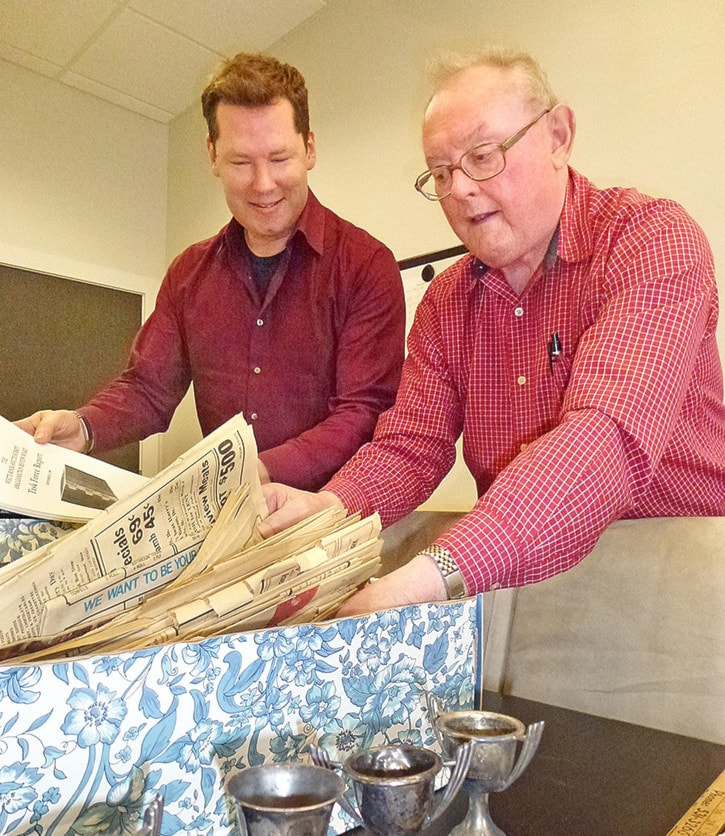For Vin Coyne, the donation of two big boxes and a large binder full of historical materials and memorabilia to White Rock Museum and Archives seems like a logical and timely step.
“There are two main reasons I’m donating it,” the former White Rock councillor, historian and retired public-relations professional and newspaperman said.
“One, it’s the 100th anniversary of the White Rock station building that houses the museum, and the other is that it’s the 60th anniversary of the first pieces I wrote for the Semiahmoo Sun newspaper on high school sports and the local men’s softball games, in 1953, when I was in high school myself.”
The collection represents “a life-time of memories” he added last month, as he and White Rock archivist Hugh Ellenwood pored over materials ranging from old newspapers and photographic prints, to advertising giveaways from early White Rock businesses.
“It’s pure gold is what it is,” said Ellenwood, noting the collection includes historic photographs and postcards he’s never seen before, as well as filling in most, if not all of the issues of the Semiahmoo Sun for 1955 – a previous gap in the Museum’s extensive archive of early local newspapers dating back to 1913.
“Vin is living history and he’s always an interesting man to talk to about the history of White Rock.”
He noted what Coyne had previously remarked – that he is one of only two people still living who were present at White Rock’s inaugural council meeting after the community formally broke away from Surrey in 1957, with the assent of the B.C. legislature (the other is Howard Kennett, retired teacher, former school trustee and former president of the Junior Chamber of Commerce).
Among the memorabilia are yardsticks advertising all but forgotten White Rock businesses, such as McPherson’s Lumberyard and Glenere’s House of Colour, and several trophies from the original White Rock Sea Festival (“one or two of which I won myself,” Coyne noted modestly).
There are also copies of the White Rock Weekly of 1945 the early minutes from community organizations such as the Junior Chamber of Commerce (dating from the 1950s) and the White Rock Parent-Teachers Association (going back to the 1940s), and a variety of reports, including one commissioned by the then-White Rock Board of Trade in 1942 which called for White Rock to establish itself as its own city – with borders similar to the present configuration.
Indeed, the collection, which Coyne describes as “a thumbnail sketch of the community in the past 50 to 70 years,” also reveals how much, surprisingly, has stayed the same – apart from immediately obvious growth and development.
“In the early days it was the same issues as today – parking, traffic, road conditions,” Coyne said. “Whenever I think of White Rock I always think of Thornton Wilder’s play Our Town – there’s a line that says: ‘we don’t lock our doors around here and nothing much changes.’”
The current donation from Coyne follows his 2007 donation to the museum of files he had received from the late journalist and community historian Margaret Lang (Hastings).
“A lot of it was given to me over the years by community people like Reg Hanslow (whose father, Fred, ran various businesses, including The Rose Jar, which sold jewelry) and the late Ruth Kendall who gave me the PTA minutes,” said Coyne.
Coyne said he’s also in the process of sorting through his extensive photo files with an eye to making further donations to the museum.
Ellenwood said he will be cataloguing the current “treasure trove” of material shortly.
“Once it’s indexed, a part of it will be digitalized, with some things online, and the rest will be accessible by researchers who want to learn more about the community,” he said.
“The material will be stored in a climate-controlled vault that will keep it stable for decades, maybe even hundreds of years.”
Coyne believes there are still many other caches of valuable White Rock and Semiahmoo Peninsula artifacts and memorabilia still lurking in dusty scrapbooks and boxes in attics – even family photos unseen for years can help fill in important pieces of the ever-evolving puzzle for historians of the local scene.
“I’d like to encourage other people to come forward with other bits and pieces they may have been keeping for years,” he said.
